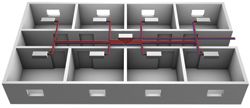A well-balanced HVAC system relies on a number of conditions to ensure it runs as efficiently as possible, keeping operating costs down whilst ensuring the system functions to its design standard. Peter Rees, technical director of hydronic solutions provider, Tour & Andersson, explains how a properly balanced waterborne system can deliver such benefits by following a set of simple conditions to manage and maintain its effectiveness.
In buildings with multiple occupants, such as offices, schools or hospitals, it can be difficult to ensure that all areas of the building are maintained at a comfortable climate. Alterations to the thermostat by occupants can result in drastic fluctuations to the temperature. In an unbalanced system, rooms may heat and cool at different rates, meaning the thermostat is often altered throughout the day in a bid to compensate for indoor climate issues.
As a result, the boiler and pump are forced to work harder to reach the desired temperature, with far more energy being used and subsequently wasted through trying to heat or cool the building. Running costs are increased as the system fails to work to an efficient level of output.
To avoid such problems, it is necessary to install a balanced, controllable system that can be easily measured to ensure each individual part operates as designed, delivering the correct output throughout the day (and using no more than the necessary level of energy to power the system). With a system that conforms to the hydronic conditions this is easily achievable as it performs as it was intended, even beyond the initial commissioning stage, ensuring water moves around the system, unhindered, to heat and cool as required.
Even though a balanced controllable system is becoming more commonplace, there are many who choose to add extra boilers and chillers to a system instead to try and counteract the problem. However, this proves to bring further problems as the system becomes increasingly costly, and may, over time, start to fail again as it ages.
An unbalanced heating and cooling system can present problems because of the way in which water works its way around using the quickest route by taking any available shortcuts. This results in an unregulated flow that subsequently causes significant fluctuations in temperature.
As such, areas of the building which are not part of the irregular flow circuit will not reach the desired temperature until much later in the day or, depending on the scale of the building, not at all. In response, occupants reach for the thermostat to alter the temperature causing the pump and boiler to work far harder. By following a set of three basic hydronic conditions, these issues can be removed, ensuring the system works as intended.
The first of these requires that the design flow is available at all terminals to ensure the indoor climate is not affected by temperature fluctuations. Without this initial condition in place, room temperatures will take far longer to be met during start-up, for example, first thing in the morning. This results in the system working harder, equating to higher energy costs.
To obtain the design flow in the first instance, it must be measured and adjusted accordingly. This is possible through careful plant sizing with hydronic balancing preventing overflow and underflow issues while detecting the degree of pump oversize, ensuring the entire plant works as expected.

The design flow
The second condition requires a minimal level of differential pressure variation across the control valves. As a result, general wear and tear problems can be reduced. Maintenance problems can occur if the level of differential pressure varies vastly as actuators and control valves work harder to counteract the problem.
This can present energy efficiency issues as room temperature oscillation can occur, which can be difficult to change.
The third condition states that there must be compatible flows at system interfaces. Without this condition, the design supply temperature can become either too high or too low. As such, the installed power is not available when it is needed such as at times of high loads, meaning the system takes a long time to deliver the correct temperature to all parts of the building.
By employing such measures, HVAC efficiency can be greatly improved, cutting energy consumption by up to 40 per cent helping to eradicate unnecessary carbon emissions while helping to reduce financial costs in turn.